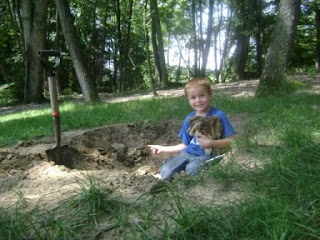A natural scavenger hunt
With the weather warming nicely and most of us still enjoying our spring fever, I thought nothing would be more fun than a challenge.
Here are your instructions. Put on shoes, appropriate outerwear, and step out your back door. Your goal is to find as many of the following as possible: a dandelion, a heron, an otter, an acorn, a fern, a buttercup, and a willow tree.
Depending on your proximity to weeds and water, you should be able to find at least a few of these. (I think even the best chemically controlled yard will sprout a dandelion now and then.) When you do find them, look twice at what you’ve actually found. A weed, as it’s been said, is simply a flower out of place. From the smallest acorn grows the strongest oak. The graceful gangliness of a Great Blue Heron is unmatched, but surely the entertainer of the year goes to the otter as they manage whiskered somersaults through the water. And anyone who has ever had the great pleasure of drinking lemonade under the shade of a willow branch is a lucky person in my book.
Tally your score and then drive to your local library. Remove your potentially muddy shoes, and straight away ask the librarian for the latest version of the Oxford Junior Dictionary, the one most commonly used in elementary schools across the country and so vibrantly colored and attractive to our youth.
Once you’ve got it, go on another scavenger hunt for those things again. See if you can find out about the biology of an acorn or find even a picture of the heron’s gangly legs.
I’ll save you time; you won’t find them. Nor will you find beaver, doe, newt, minnow, starling, wren, lavender, fungus, beech, or pasture.
They’ve been taken out of the dictionary. There wasn’t enough room for other new important words for them to include. So instead of vine and canary you’ll find BlackBerry (the phone), blog, mp3, voicemail, chatroom, broadband, and “cut and paste.”
This news hit the nature circuit a while back, but is rather new to me, and as someone who prides herself on muddy shoes and poison ivy, I find it rather appalling. Nature as I know it, as my parents and my grandparents know it, is disappearing not only in real life but also on paper.
Gone are the days when kids fell out of trees and came home with pet frogs. Insect bites and sunshine have become seriously dangerous things that we basically medicate ourselves and our children for before we send anyone out the door. Kids have gotten so far away from just going outside to play that many don’t even know how to do it without toting along a Nintendo DS.
The exception to this, I’m proud to say, is my son who worked for two summers straight using plastic yard tools to dig out a rotten stump. At ages 4 and 5, he worked tirelessly to remove a giant stump until one day last autumn, he finally pulled it out. We all cheered—even the neighbors congratulated him. Then we asked what he’s going to do now, and he simply shrugged, picked up his shovel, and started digging.
“Maybe a pond,” he said. “We could get some frogs.”
He is an oddity, but one that I need to nurture, which is why I bought him a real shovel and a kid’s backyard nature guide.
After hearing about the latest edition of the dictionary, I know now that it’s become not only my right, but my job as a parent to introduce my kids to the wonders of nature. And I suggest that any other parent (or grandparent) who shares similar wonderful memories of building forts in trees, riding bikes until the street lights came on, and scraped their legs to shreds while picking blackberries, do the same.
And by blackberries, I of course mean the juicy kind that stains your face and hands purple, not the kind with buttons and numbers that you’ll find if you look it up.
Here are your instructions. Put on shoes, appropriate outerwear, and step out your back door. Your goal is to find as many of the following as possible: a dandelion, a heron, an otter, an acorn, a fern, a buttercup, and a willow tree.
Depending on your proximity to weeds and water, you should be able to find at least a few of these. (I think even the best chemically controlled yard will sprout a dandelion now and then.) When you do find them, look twice at what you’ve actually found. A weed, as it’s been said, is simply a flower out of place. From the smallest acorn grows the strongest oak. The graceful gangliness of a Great Blue Heron is unmatched, but surely the entertainer of the year goes to the otter as they manage whiskered somersaults through the water. And anyone who has ever had the great pleasure of drinking lemonade under the shade of a willow branch is a lucky person in my book.
Tally your score and then drive to your local library. Remove your potentially muddy shoes, and straight away ask the librarian for the latest version of the Oxford Junior Dictionary, the one most commonly used in elementary schools across the country and so vibrantly colored and attractive to our youth.
Once you’ve got it, go on another scavenger hunt for those things again. See if you can find out about the biology of an acorn or find even a picture of the heron’s gangly legs.
I’ll save you time; you won’t find them. Nor will you find beaver, doe, newt, minnow, starling, wren, lavender, fungus, beech, or pasture.
They’ve been taken out of the dictionary. There wasn’t enough room for other new important words for them to include. So instead of vine and canary you’ll find BlackBerry (the phone), blog, mp3, voicemail, chatroom, broadband, and “cut and paste.”
This news hit the nature circuit a while back, but is rather new to me, and as someone who prides herself on muddy shoes and poison ivy, I find it rather appalling. Nature as I know it, as my parents and my grandparents know it, is disappearing not only in real life but also on paper.
Gone are the days when kids fell out of trees and came home with pet frogs. Insect bites and sunshine have become seriously dangerous things that we basically medicate ourselves and our children for before we send anyone out the door. Kids have gotten so far away from just going outside to play that many don’t even know how to do it without toting along a Nintendo DS.
The exception to this, I’m proud to say, is my son who worked for two summers straight using plastic yard tools to dig out a rotten stump. At ages 4 and 5, he worked tirelessly to remove a giant stump until one day last autumn, he finally pulled it out. We all cheered—even the neighbors congratulated him. Then we asked what he’s going to do now, and he simply shrugged, picked up his shovel, and started digging.
“Maybe a pond,” he said. “We could get some frogs.”

He is an oddity, but one that I need to nurture, which is why I bought him a real shovel and a kid’s backyard nature guide.
After hearing about the latest edition of the dictionary, I know now that it’s become not only my right, but my job as a parent to introduce my kids to the wonders of nature. And I suggest that any other parent (or grandparent) who shares similar wonderful memories of building forts in trees, riding bikes until the street lights came on, and scraped their legs to shreds while picking blackberries, do the same.
And by blackberries, I of course mean the juicy kind that stains your face and hands purple, not the kind with buttons and numbers that you’ll find if you look it up.


Comments